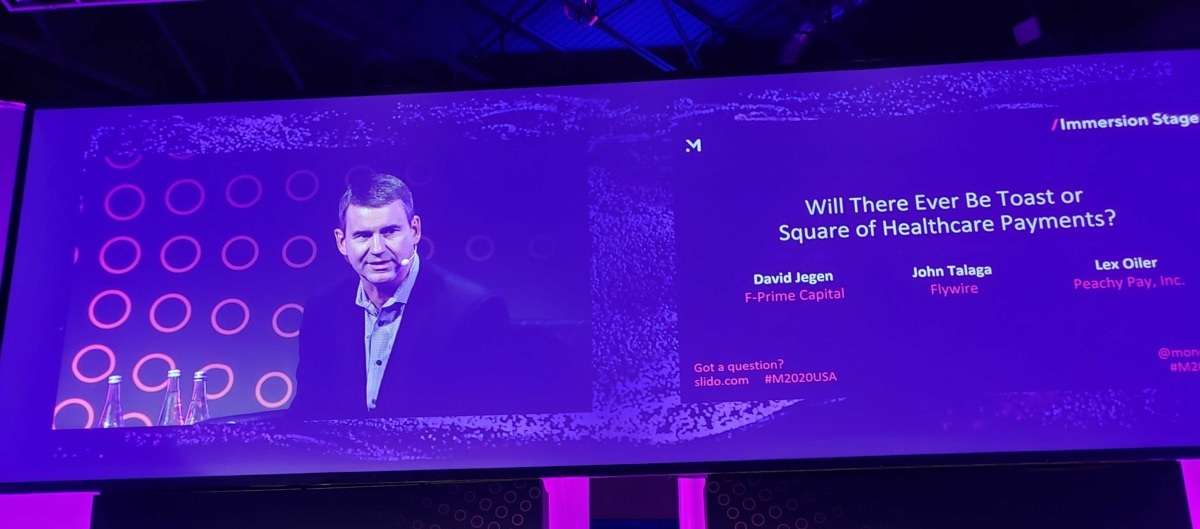
In late October, I had the opportunity to participate in a panel discussion at Money2020 about the future of healthcare payments. I was joined by Lex Oiler, founder and CEO of Peachy, another company in the healthcare payments space. The panel was moderated by David Jegen, Managing Partner of F-Prime Capital’s Tech Fund and a long-time participant, observer, and advisor in the fintech world.
There was a lot of interest in the session — and for good reason. Complex payment processes combined with higher insurance premiums, deductibles and out-of-pocket expenses all mean a much larger financial responsibility for consumers today, and a lot of concern about how to pay for it. Flywire recently surveyed over 2000 consumers in the US to understand how they were dealing with the issue. 46% said they won’t be able to pay for an unexpected illness or surgery in one lump sum. 40% have postponed a procedure or treatment because they couldn’t afford it. And 84% believe the healthcare payment system needs to be streamlined. It’s a problem a lot of people are focused on.
Why Are Healthcare Payments So Difficult?
Will the healthcare payment experience ever become as frictionless as it is in retail? That was the overarching question posed by our moderator, David Jegen. From the perspective of the healthcare and payments industry, my response was ‘no way.’ Aside from certain routine physician visits or procedures when the costs are fixed, healthcare services are entirely different than buying something at retail. As a consumer, you typically know what you’re buying, and how much it will cost. You don’t receive those goods or services until you’ve made payment, or committed to through services like Buy Now, Pay Later.
For acute services in healthcare that carry the highest price tags, the extent of the services and final cost can be highly unpredictable. In some cases, you are acquiring services and products while you are medicated, under duress, or even unconscious. You may have very little control or choice over what products or services you receive. And there are almost always additional charges which need to be collected after the service is delivered.

Yet, when we look at it from the viewpoint of the patient, there are a lot of factors suggesting that simplified payment processes could be a key part of the path to affordability, ease-of-use, patient engagement, and self-service. Healthcare consumers are a lot savvier today. They are taking more control over their healthcare decisions, engaging with care providers via telehealth, using apps to track their condition, and taking ownership of their medical records. In short, they are acting a lot less like patients and more like consumers. And as they take on a greater share of their healthcare expenditures, they are also demanding payment solutions that give them more control by making the process more transparent, manageable, and affordable. Simply put, they expect it to be more like the rest of their life.
Moving in the Right Direction
A lot of good things are happening now to make healthcare payments easier. Regulation and legislation around price transparency and pre-service estimates should give patients a much better understanding of their financial responsibility to prevent surprises. And solutions like Flywire are simplifying the process by enabling healthcare providers to consolidate separate services and charges into a single view so patients can see everything they are responsible for in one place. In addition, we are using AI and personalization to engage patients proactively and offer payment options and installment plans based on their ability to pay. This is making healthcare payments a lot easier and more affordable, while helping hospitals and health systems meet patients where they are.
Despite all the progress, the inherent conditions of healthcare may make a Square-like payment experience unrealistic. Hospitals have on average ~1,000 IT systems in place. For payment solutions to work in healthcare, they need to provide more than payment processing; they need to deploy software that can integrate into existing systems and workflow to create efficiencies for both the hospital and the patient. There are also important regulatory and compliance standards like HIPAA to account for. A lot of the hard stuff happens on the backend, which requires unique solution components for complex environments. If you can’t do that well to drive payments, processing the payment becomes irrelevant.
